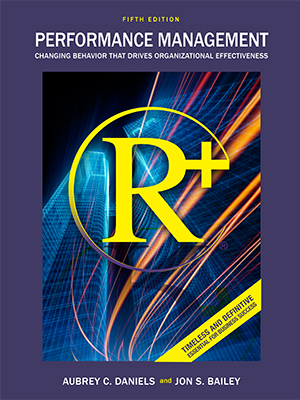The Role of the Establishing Operation in Performance Management: Changing the Value of Consequences
Dr. Jack Michael of Western Michigan University has argued that the effect of antecedents and consequences on behavior is dependent on a variable, which he calls the "establishing operation." Dr. Michael defines establishing operations as motivating variables having two effects:
-
They momentarily alter the reinforcing or punishing effectiveness of some events or objects.
- They momentarily alter the frequency of behavior that, in the past, has been consequated with those events or objects whose value has been altered.
 Let's look at an example that will be familiar to many readers. Suppose two departments of a company implement Performance Management. The manager and supervisors of Department A decide to use social reinforcement almost exclusively. They begin to implement their performance improvement plans (PIPs) and performance begins to improve. Suddenly the employees of Department A learn about the reinforcers being used in Department B. The manager and supervisors of Department B chose to use mostly tangible reinforcers including free lunches, movie tickets, better equipment, gourmet coffee, and so on. Learning about the tangible reinforcers being delivered in Department B serves as an establishing operation in that it reduces the reinforcing value of the social reinforcement the people of Department A were receiving and reduces the behavior which had lead to that social reinforcement. In other words, learning about the "goodies" the other department was getting reduced the value of the social reinforcement that had previously been effective and explains the decrease in performance improvement.
Let's look at an example that will be familiar to many readers. Suppose two departments of a company implement Performance Management. The manager and supervisors of Department A decide to use social reinforcement almost exclusively. They begin to implement their performance improvement plans (PIPs) and performance begins to improve. Suddenly the employees of Department A learn about the reinforcers being used in Department B. The manager and supervisors of Department B chose to use mostly tangible reinforcers including free lunches, movie tickets, better equipment, gourmet coffee, and so on. Learning about the tangible reinforcers being delivered in Department B serves as an establishing operation in that it reduces the reinforcing value of the social reinforcement the people of Department A were receiving and reduces the behavior which had lead to that social reinforcement. In other words, learning about the "goodies" the other department was getting reduced the value of the social reinforcement that had previously been effective and explains the decrease in performance improvement.
As a more complex example, imagine a small manufacturing plant in a remote location that is part of a larger organization with headquarters in another state. The managers and supervisors in this plant have completed Performance Management training and are actively measuring a variety of plant performance measures including profitability. All employees of the plant get feedback on the performance measures and the managers and supervisors reinforce the behaviors associated with improved performance. The plant is profitable, but not by a large margin. Since they are doing better than they did in previous years, everyone at the plant is proud of his or her performance. One day, they get word from the head office that the larger organization is losing money and they are going to have to downsize. Unless the plant can improve its profitability by 5 percent, it will be shut down. This announcement serves as an establishing operation in that it has the effect of altering the reinforcing and punishing value of several things (the first part of Michael's definition). For example, before the announcement, a small profit was reinforcing – the plant employees celebrated. After the announcement, a small profit is punishing because it is associated with the closing of the plant and the loss of jobs. After the announcement, any indication of reduced costs or increased productivity will be more reinforcing than it was before the announcement. Again, the reinforcing and punishing value of existing stimuli has been altered. In addition, the announcement has the effect of increasing the frequency of behavior that will lead to greater profits (the second part of Michael's definition). Now employees will do more of those things that will lead to greater profits. Remember, these people were already being reinforced for the right behaviors. What the announcement (the establishing operation) did was to alter the value of those existing consequences and to make it more likely people would engage in the behavior that will lead to the positive consequences and avoid the negative consequences.
 In the above example, the establishing operation was not controlled by the people in the plant — the head office set it up. In many cases, people can change the establishing operations in their own work setting purposefully. A good example is when we ask for "top management support" of a change initiative. Functionally, top management support could be considered an establishing operation for the behaviors associated with compliance with the change initiative. All management change initiatives require changes in behavior. PM is a great example. To effectively implement PM in an organization, employees must do things such as attend classes, write PIPs, develop measurement tools, provide feedback, or reinforce appropriate behaviors. Unfortunately, not all of those behaviors are immediately reinforcing. By getting top management to participate in an initiative, we are changing the value of the antecedents and consequences associated with participating in that initiative. If top management is well-liked and respected, then their participation will make it more reinforcing for others to participate and make it more likely that they will engage in the behaviors associated with the initiative.
In the above example, the establishing operation was not controlled by the people in the plant — the head office set it up. In many cases, people can change the establishing operations in their own work setting purposefully. A good example is when we ask for "top management support" of a change initiative. Functionally, top management support could be considered an establishing operation for the behaviors associated with compliance with the change initiative. All management change initiatives require changes in behavior. PM is a great example. To effectively implement PM in an organization, employees must do things such as attend classes, write PIPs, develop measurement tools, provide feedback, or reinforce appropriate behaviors. Unfortunately, not all of those behaviors are immediately reinforcing. By getting top management to participate in an initiative, we are changing the value of the antecedents and consequences associated with participating in that initiative. If top management is well-liked and respected, then their participation will make it more reinforcing for others to participate and make it more likely that they will engage in the behaviors associated with the initiative.
For example, attending training tends to be punishing to many people (because they are too busy, or because they don't see the value of the training prior to attending). However, when top management is highly involved and shows enthusiasm and commitment to the initiative, this serves to alter the antecedents and consequences associated with training (among other things), and most people quickly sign up for the training and find it very reinforcing.
There is a multitude of potential reinforcers in work settings. Unfortunately, companies have not always been effective at tapping into them. Looking at the conditions under which existing events or objects will be considered reinforcing and then creating those conditions may open up a new world of reinforcement. The establishing operation is a behavioral concept that prompts us to look at our programs in the greater context in which they operate and enables us to investigate the possibility of maximizing the reinforcers available.
Published May 2013


